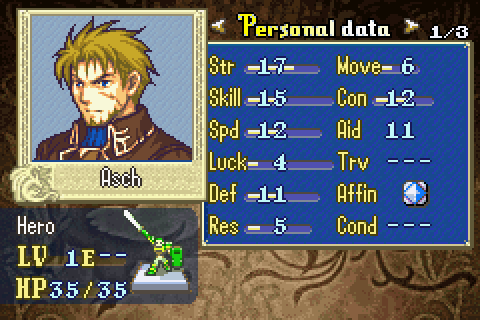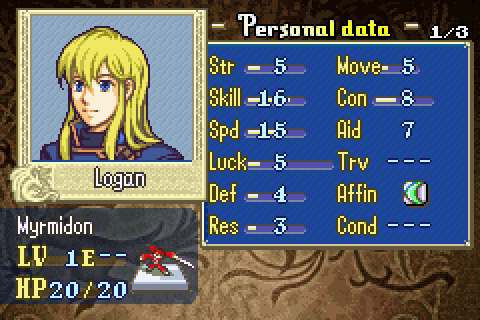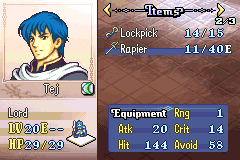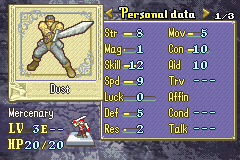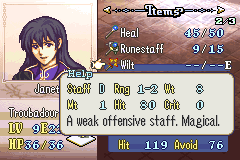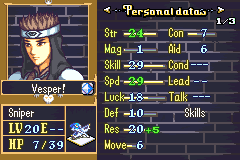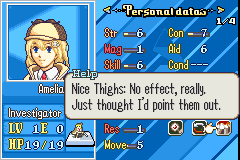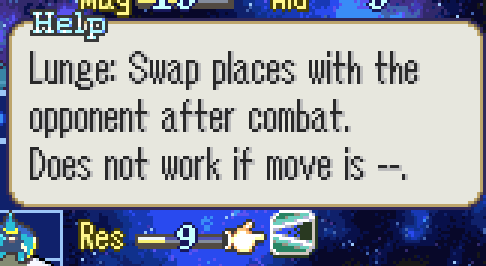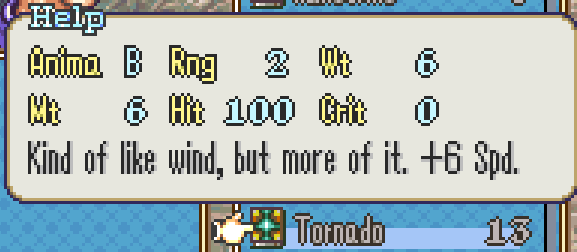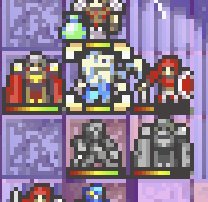Cutting to the chase right away, I’d like to write about Colm from Sacred Stones Reforged.
(Note: I realize that a redux may not be considered a custom campaign. However, I think the unit I’m going to discuss is distinct enough from the vanilla counterpart that it still warrants an effortpost.)
Colm is a unit whose status in vanilla, or lack thereof, is well known. He’s not a unit the more devoted fans use for combat, unless they are meming. He’s generally a tool with which you steal a couple of items, open a couple of locks, and maybe pick up a desert item. You can also use him as a mobile torch on fog maps. All in all, that’s certainly not the worst package, but it’s not anything too exciting. It’s normal Thief things. Matthew can do all of that in FE7.
In Sacred Stones Reforged, however, which is one of many reduxes of FE8, Colm is a significantly more exciting unit. And most of it boils down to the skill he starts with. Shadowstep.
“Hides this unit” is NOT Shade, unlike what you may believe. It’s not that enemies will not attack Colm unless he is the only available target. This skill provides true invisibility. Even if he is the only target in the enemies’ range, they won’t move toward him or attack him. He’s treated as if he isn’t there.
This is the centralizing skill in Reforged Colm’s toolkit, and it’s also a big reason why he’s fun to use. As long as you can get him to kill an enemy on each turn, he can be basically invulnerable, moving around the map and assassinating targets one by one without ever being threatened. And assassinate he does, because if you promote him to Assassin, he also receives the following skill:
You might think landing a critical hit is unreliable, but there are ways to make it a lot more reliable. Chief among them is a dagger called Black Fang, which has 50 Crit and can be bought in the midgame for 6000 Gold. Because weapons are unbreakable in Sacred Stones Reforged, once you buy that knife, Colm can spam it forever. And spam he did – in my playthrough on Lunatic Mode, I used it to kill countless enemies and prepare Silencer for future combats. In fact, every time I deployed Colm (which was on every map since he joined), the gameplay pattern was the same: walk him 6 tiles forward, kill an enemy, walk him 6 more tiles forward on the next turn, kill an enemy, and all while never having to bother with checking enemy ranges because he would never get attacked.
Colm also has other options. As mentioned above, Thieves can use daggers in Reforged, and while they can still use swords, I didn’t bother with that. Colm starts with a low sword rank and daggers don’t raise his sword rank, so I would’ve had to avoid using daggers in order to let him use better swords. I didn’t want to do that, especially since I was already using Joshua for my sword needs. Instead, I just spammed daggers – because Black Fang is not the only good dagger in the game.
One of the best weapons in the game, in my opinion, is Stiletto – the dagger Colm joins with. It has unremarkable stats, but it has a very crucial effect – it ignores the target’s Def. With Silencer active, Colm can deal damage equal to 4 times his Str to any boss in the game except Fomortiis. And it turns out that this amount of damage one-shots almost every boss in the game, despite Colm not being known for a high Str stat. I used Silencer with the Stiletto to have Colm one-shot Selena, Vigarde, Caellach, and Orson, to name a few bosses. It also certainly helps that daggers ignore the weapon triangle, the effects of which are more pronounced in Reforged; I could utilize its Def-piercing properties with impunity even against targets who used lances (like many of the bosses I just mentioned Colm one-shotting). Moreover, on the Selena map in particular, I walked Colm across all the rivers one by one (because Assassin can Riverwalk) and killed Selena in one hit with Stiletto Silencer without any of the enemies ever being able to attack Colm (because they could never detect his presence). It felt like an actual assassination – the only time an FE unit made me feel this way. Reforged Colm, to put it succinctly, is the assassin fantasy put into an FE context – and it’s the best-represented assassin fantasy I’ve ever seen in a romhack.
One more thing that benefits Colm in Reforged is the fact it’s much easier – and quicker – to build supports. I had him build an A support with Neimi in no time at all, and it had a meaningful impact on their performance, as the offensive bonuses the support provides are remarkable. You might wonder “but why would I want to use Neimi just to buff Colm,” and the answer is “because Neimi is also awesome in this hack.”
That’s right, this is a double feature and a double whammy. I’d also like to discuss Neimi from Sacred Stones Reforged.
Much like Colm’s usage is oriented around two skills – Shadowstep and Silencer – Neimi’s usage is also oriented around two skills, although one of them comes from a weapon and not from her own toolkit. Her personal skill is this:
This is Bowrange +1, and if you thought it was good in Three Houses, it’s arguably even better here. The maps and enemies of Sacred Stones were NOT designed around the idea of your units having access to perpetual 3 Range, and you can really feel it while playing this hack. Zethla’s Heir lets Neimi attack almost every enemy without having to worry about getting countered, which makes her low durability a significantly lesser concern. And while you might think her offense is insufficient to kill things, based on her miserable performance in vanilla FE8, you’ll be surprised; in Reforged, she’s more than capable of killing things, partly because she can build a Colm support in no time, partly because her stats were buffed, and partly because she can snowball a lot. The reason she can snowball is a weapon you can acquire at the end of Chapter 4:
(feat. Neimi giving you a final look before she kills you)
A Galeforce bow combined with the ability to avoid counters allows Neimi to reliably pick up kills, and often multiple kills per turn. I was playing on Lunatic Mode, so the enemies were the strongest they could possibly be, and she was still more than capable of getting two kills each turn for most of the game. I did not grind her levels – and in fact, this is impossible to do outside of the arena, because the Tower of Valni doesn’t unlock until Darkling Woods. She is just that good.
What additionally snowballed Neimi’s performance was her ability to promote to Ranger. Just like in vanilla, Ranger is a 7 Mov cavalry class that can riverwalk, but with Neimi being able to attack from 3 Range and refresh her turn once by using Stormbow, she had immense flexibility. There were many, many enemies I killed across a wall with her that nobody else could, many fliers she took down in one round, many other enemy types she made look like a joke. I believe that at the end of my run, Neimi had the highest killcount by far, because the ability to kill two enemies each turn without the need for a Dance snowballs into a large killcount very fast. She could even perform hit-and-run attacks, because with an effective range of 10 tiles and the ability to self-refresh, this wasn’t difficult to achieve in the slightest. Reforged’s Ranger class doesn’t have access to swords, but that was completely irrelevant. I honestly forgot Neimi couldn’t fight at 1 Range, because it was never necessary. Her job was to kill things on player phase, and that she did.
I believe you can see how Neimi’s toolkit makes her synergetic with Colm as well. Apart from them having a very fast support, they are also both player-phase units who can reliably one-round, and both of whom can riverwalk. Neimi can kill two enemies at a time, Colm can kill one and hide himself. I was often able to send them both down a path and they would systematically kill the enemies there without taking damage, just because they were so flexible in terms of potential positioning. Neimi could clear the way for Colm, Colm could kill an enemy threatening Neimi, and they could do that while benefitting from their mutual offensive support bonuses.
All in all, I have never had as much fun using Colm and Neimi as I did in Reforged. Not in any FE8 redux, and certainly not in vanilla. Reforged made these units FUN – and I was playing on Lunatic Mode, so I’m not shilling their performance on a difficulty where anyone can perform. Colm is the assassin fantasy personified, and Neimi is a mobile, player-phase, bowrange-abusing killing machine who reminds me the most of Beryl from Souls of the Forest. Whenever I replay Reforged and decide not to use them, I’m certainly going to miss them.
But to you, reader, who may not have played Reforged – if you do decide to play the hack, give Colm and Neimi a shot. I promise they are far, far unlike their vanilla incarnations in both potential and fun.
